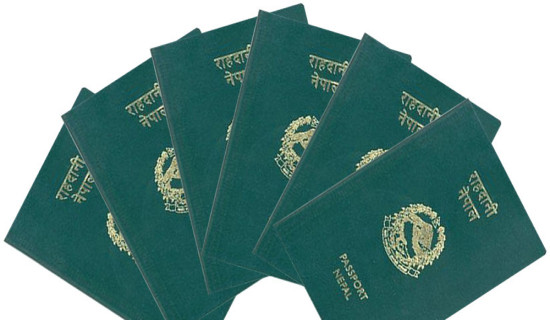- Wednesday, 24 December 2025
Garment sector on path of gradual recovery
Kathmandu, Apr. 9: The export of readymade garments, which plays a major role in reducing Nepal's trade deficit, is on increasing trend.
It has been seen that the export of readymade garments, which occupy a share of around 6 per cent of the items exported from Nepal, has been increasing in recent months and creates a ray of hope among businessmen to boost export.
According to the data of the Trade and Export Promotion Centre (TEPC), Nepal has exported readymade garments worth Rs. 6.18 billion during the first eight months of the current fiscal year. Nepal has exported about 9,648,675 pieces of readymade garments worth Rs. 6.18 billion to various countries of the world.
The readymade garment occupies the fourth place among the products exported from Nepal. During the review period, iron and steel occupied the first position with exports of Rs. 11.63 billion, yarns second with exports of Rs. 7.51 billion and woolen carpets with exports of Rs. 6.9 billion is in third place.
As compared to the last fiscal year, the export of readymade garments increased by 16 per cent during the same period of the current fiscal year. Nepal exported about 8,446,601 million pieces of readymade garments worth Rs. 5.33 billion during the same period last fiscal year 2022/23.
The present rate of growth in the export of readymade garments is encouraging and creates a ray of hope to revive its export and reach in its earlier state of 2000s, said Pashupati Dev Pandey, president of Garment Association Nepal (GAN).
He said that on the basis of the amount of exported goods, garment stands at the fourth position, and it indicates a promising future for the export of such goods from the country.
The COVID-19 pandemic had a big impact on the business of traders who had been exporting readymade garments to various countries of the world for a long time.
At that time, due to the high cost of production and transportation, businessmen could not export a significant amount of clothes. However, Pandey said that the market is improving now after the COVID-19 pandemic.
According to the TEPC statistics, the country exported 13,189,729 pieces of readymade garments worth Rs. 8.21 billion during the last fiscal year 2022/23.
Similarly, 20,467,535 pieces of readymade garments worth Rs. 7.23 billion were exported in the fiscal year 2021/22 and 11,863,527 prices of readymade garments worth Rs. Rs. 5.3 billion in the fiscal year 2020/21.
Similarly, 9,176,172 pieces of readymade garments worth Rs. 4.87 billion had been exported in the fiscal year 2019/20.
America is the main market for readymade garments produced in Nepal. After America, it is being exported to the United Kingdom, Germany, France, Japan, Italy, UAE, Switzerland, Sweden, Spain, New Zealand, South Korea, Ireland, India, Finland, Denmark, Czech Republic, Canada, Austria and Australia.
The readymade garment industries were established in Nepal in the 1980s. In 2001/02, this industry was established as a major industrial commodity that earned foreign exchange by exporting readymade garments worth about USD 400 million annually.
"After 2005, the quota system ended with the expiry of the Multi Fiber Agreement with the US government. As a result, the export continued to decline," said Pandey.
At that time, the investment of Rs. 6.5 billion in this sector almost evaporated. Millions lost their jobs. At that time, 1,280 readymade garment industries were operating, and direct and indirect employment was available at around 1 million, he said.
Lately, the industry has started to pick up slowly. The export of readymade garments has been maintained at nearly Rs. 9 billion, with 100 industries operating. Around 35,000 people have got direct employment.
"This is not a satisfactory situation for us. Therefore, I believe that there will be a special initiative of the government to improve the export by providing facilities to the industries and businessmen to improve it," Pandey told The Rising Nepal.
High production cost becomes a challenges
Due to the fact that Nepali readymade garments are more expensive than the costs of neighbouring countries by more than 27 per cent, said Pandey.
“High cost of production is a challenge for us to be competitive in the international market. So, we are looking for support to reduce the cost of production,” he said.
He said that the government should increase the rate of cash subsidy from 4 per cent to maintain a minimum of 10 per cent to reduce the cost of production and make it competitive.
Both Nepal and Bangladesh established readymade garment industries in the 80s and brought them into operation. At that time, the Bangladesh government provided cash subsidies of up to 25 per cent and other export-friendly facilities to make it competitive at the international level.
Providing employment to more than 4 million people from around 4,300 industries, Bangladesh has been exporting 62 times more than Nepal in recent times.
By simplifying the process of obtaining the current cash incentive, provision should be made for it to be received in the bank account of the concerned industry within 35 days of the payment in foreign currency through the bank, he said.
He said that the government should arrange for the provision to provide concession loans to the garment industries. The duty-free facility of 77 items provided by the US government through the Nepal Trade Preference Programme (NTPP) will end in 2025, said Pandey.
According to him, in addition to re-demanding the NTPP, efforts should be made to include Fast Moving and Core Competence items, which have great export potential in the programme.
In the current situation where the relationship between Nepal and the United States of America government has reached a higher level, it seems that special efforts should be made to provide duty-free/quota-free facilities for the export of Nepali goods to the United States market, he said.
















-original-thumb.jpg)